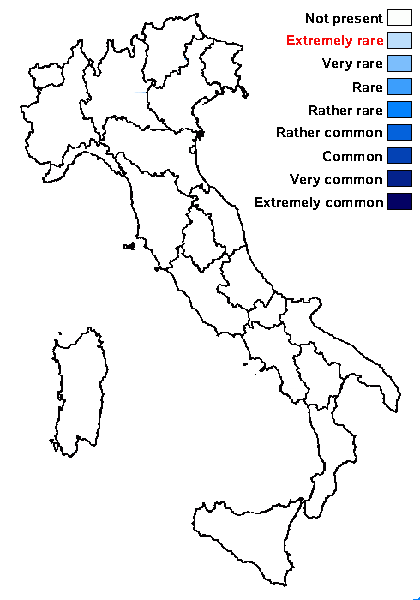Placidium fingens (Breuss) Breuss
Ann. naturhist. Mus. Wien, Ser. B, Bot. Zool., 98, suppl.: 38, 1996. Basionym: Catapyrenium fingens Breuss - Stapfia, 23: 79, 1990
Synonyms:
Distribution:
Description: Thallus squamulose, pale to medium brown, the squamules up to 6 mm broad, rather thin (0.24-0.33 mm thick), lobate, scattered to contiguous, fully adpressed to the substrate, with slightly ascending margins, at least the young ones with very thin hairs at the margins (microscope!). Lower surface whitish to pale brown, attached by pale, 6-8 μm thick rhizohyphae. Upper cortex paraplectenchymatous, 35-75 μm thick, with a thin epinecral layer; medulla white, of more or less globose cells; lower cortex not well-differentiated from the medulla, with cells not arranged in vertical rows, the lowermost ones often brown-walled. Perithecia frequent, laminal, broadly pyriform, immersed in the squamules, up to 0.5 mm wide. Exciple colourless throughout; paraphyses absent, substituted by periphyses; hymenium K/I+ blue. Asci 8-spored, cylindrical, thin-walled, non-amyloid and without an ocular chamber. Ascospores 1-celled, hyaline, ellipsoid, thin-walled, uniseriately arranged in the asci, (12-)15-17(-18) x (5-)5-7 μm. Pycnidia laminal, immersed. Conidia cylindrical to bacilliform, (4-)5-6 x 1-1.5 μm. Photobiont chlorococcoid. Spot tests: K-, C-, KC-, P-, UV-. Chemistry: without lichen substances. Note: a species described from Macaronesia and also known from the Iberian Peninsula, where it is generally rare; it grows on calcareous soil and fissures of calciferous rocks, from the montane to the alpine belts; to be looked for in Italy.
Growth form: Crustose
Substrata: rocks, soil, terricolous mosses, and plant debris
Photobiont: green algae other than Trentepohlia
Reproductive strategy: mainly sexual

Predictive model
Growth form: Crustose
Substrata: rocks, soil, terricolous mosses, and plant debris
Photobiont: green algae other than Trentepohlia
Reproductive strategy: mainly sexual

Predictive model
 Index Fungorum
Index Fungorum
 GBIF
GBIF

